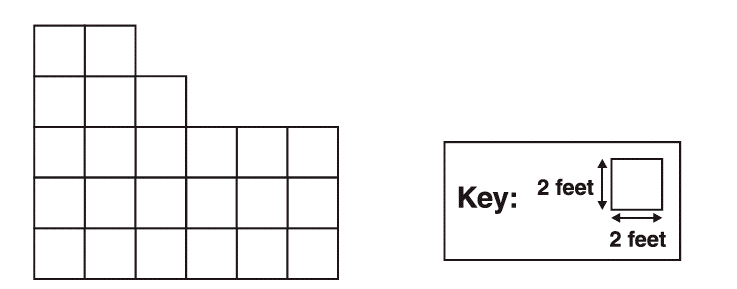
The “Rabbit Fence” Question:
A Typical Grade 3 Math Prompt
analyzed by Timothy Horrigan, former Measured Progress test scorer
Third graders have it easier than the older kids in one respect: they get to write their answers right on the test booklets, right on the same page where the question is— rather than having to refer to separate answer sheets. (The slightly paradoxical term used in the test-scoring business for this arrangement is “disposable test booklets”— even though test booklets are rarely reused even when there are separate answer sheets. Ironically, the testing contractor actually keeps the “disposable” booklets while discarding the “non-disposable” ones.)
The third-grade questions are fairly challenging for this grade level. The “rabbit fence” queastion was a popular one which I ran into more than once during my years as a test scorer.
The scenario is that Mr. Chen's students have each been assigned a 2-by-2-foot garden plot. There are 23 plots, arranged within a 10-foot by 12-foot rectangle. The question is:
Mr. Chen has planned a garden for his class. Each student will plant a square section measuring 2 feet by 2 feet. The plan above shows how the square sections will be arranged. The garden will need fencing around it to keep the rabbits out. How much fencing is needed to go around the whole garden?

The intended answer is 44 feet. If you go around all the circuit ABCDE (as shown below) there are 22 exposed sides, and 22 sides * 2 feet/side = 44 feet. (In most grades, lengths are typically in metres, but evidently the metric system is too advanced for third graders.)
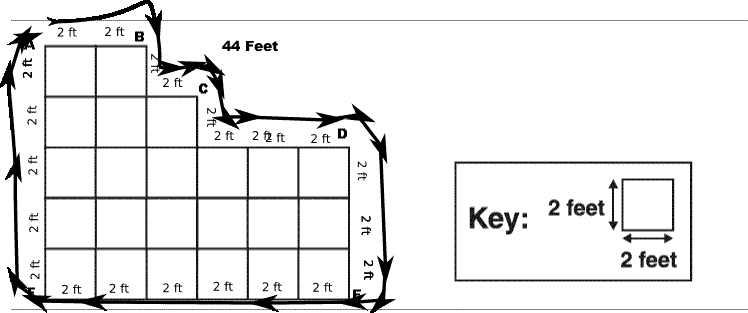
The kid has to explain the answer. He would be penalized if he simply asserted that the larger 10 by 12 foot rectangle has a perimeter of 44 feet (even though this yields the same number.)
Although I don't remember seeing these answers, and they would have been penalized if they had shown up, there are a couple smart-aleck answers which would allow Mr. Chen to use less than 44 feet of fencing to enclose his garden plot
You could simply run a diagonal length of fencing from B to D. The Pythagorean Theorem tells you that the length of the segment BD would be:
|
sqrt(4^2 + 8^2) |
= sqrt(16 + 64) |
|
|
= sqrt (80) |
|
|
= approximately 8.94 feet |
|
|
= approximately 9 feet. |
(You could alternatively measure
the 9 feet by drawing the line and then making a ruler which matches
the squares on the diagram. This is made easier by the fact that
the “Key” inset is actually drawn to the same scale as
the map of the garden plot, even though an optical illusion makes
the “Key” square look larger at first glance.) This
would reduce the fence's overall length from 44 feet to 40.94 feet
(or 41 feet.)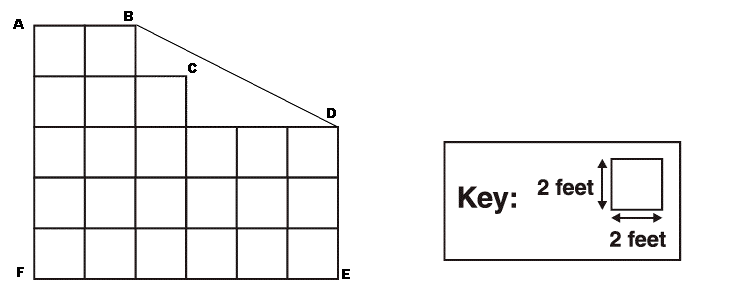
You could move the two plots in
the top row down to the second row down, in which case the 23 plots
fit within a 4 row by 6 column grid with a perimeter of 40 feet.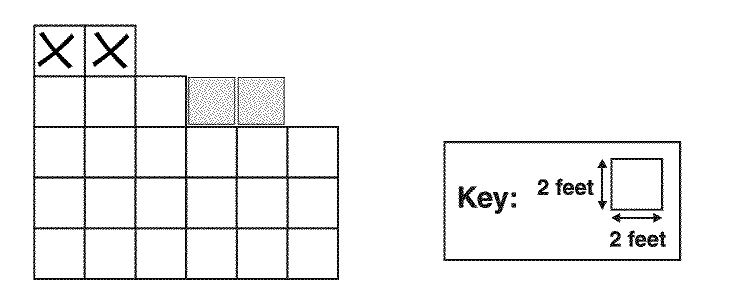
Or: you could arrange the 23 plots so they fit inside a 5 row by 5 column grid, with (once again) a perimeter of 40 feet.
The children who are advanced enough to come up with unintended answers like these also tend to be advanced enough to know what is and is not on their particular grade's curriculum. The few 3rd Graders who know how to use the Pythagorean Theorem (as in alternate answer “a”) are generally also well aware that the test developers wouldn't expect a 3rd Grader to think of such a thing.
In any case, here is the scoring rubric. This is one of those rubrics with test points and score points. There are 4 score points and 4 test points, but you can have ½ test points. The test scorer has to do both the addition and the translation in her head: the iScore software used at Measured Progress only allows you to enter the final score-point value.
4: Student earns a total of 4 points.
3: Student earns a total of 3 points.
2: Student earns a total of 2 or 2½ points.
1: Student earns a total of ½ to 1½ points.
0: Response is incorrect or irrelevant.
Blank: No response.
Training Notes:
Points for this item are given for the following:
Part a:
2 points: Student provides the correct answer (44 feet). (Note: To receive 2 points, the unit must be labeled.)
1 point: Student provides an acceptable answer ranging from 40 to 45. The answer might be labeled incorrectly or the label might be missing.
1⁄2 point: Student provides an answer of 22.
Part b:
2 points: The student describes a complete, correct strategy.
1 point: The student provides an incomplete explanation of the strategy used. OR The student provides an incorrect answer, but does show an appropriate approach (e.g., computational error).
1⁄2 point: The student provides a weak explanation that shows a partial understanding of perimeter.
Anchor 4:
The intended answer.
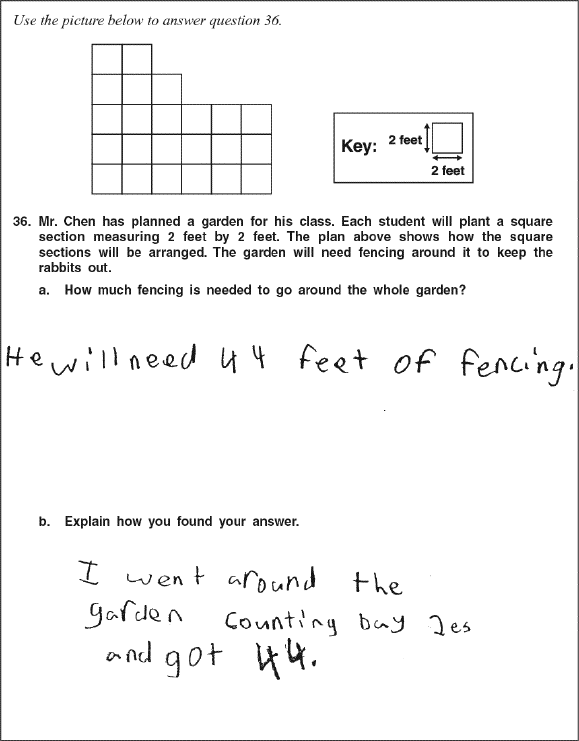
Anchor 3:
This student gets docked a point on part A for counting 42 feet instead of 44; so she gets 3 test points (1 on A and 2 on B) which corresponds to 3 score points.
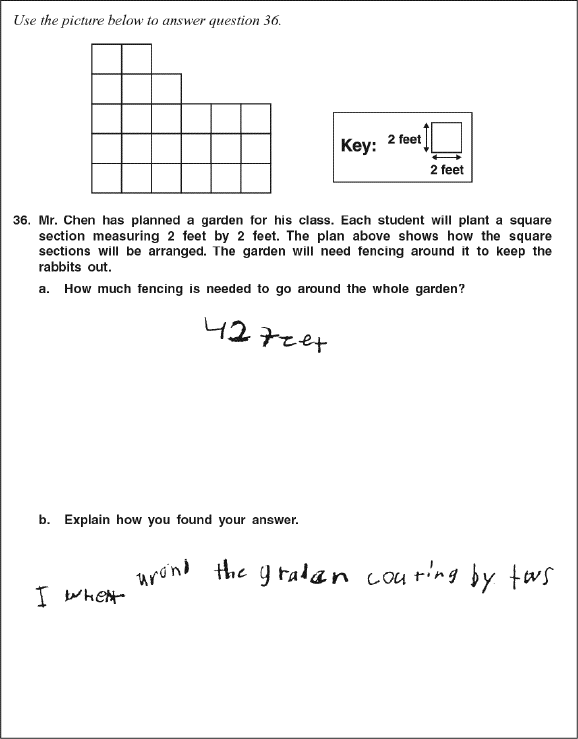
Anchor 2:
This student aced part A, but her explanation in part B was evidently worth at most ½ points. As I recall, this was not a typical 2: a more common way to get 2 points was to get 1 point in part A with a slightly wrong answer (i.e., between 40 and 45 feet but not 44) and 1 point in B (for a vague explanation of strategy.) This anchor 2 does show how it is possible to get the right answer but still get a low score.
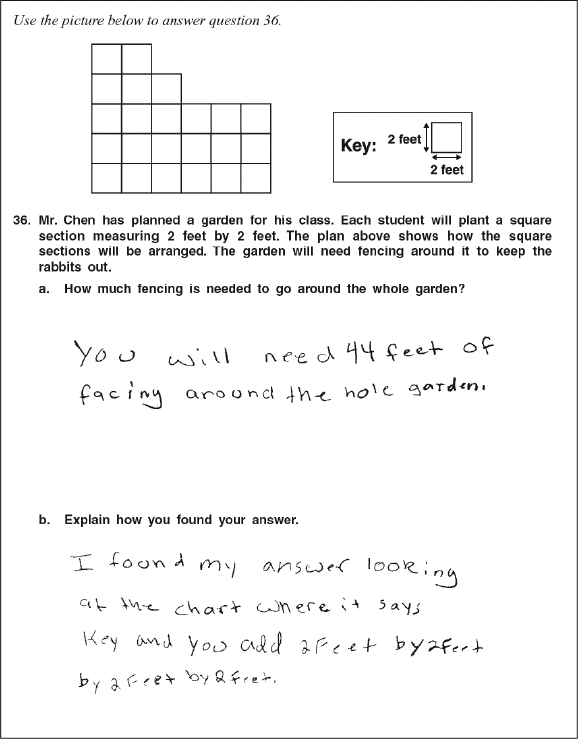
Anchor 1:
This is (apparently) a classic “minimal 1”: i.e., the student gave a totally wrong answer to the question while still displaying some grasp of the skill being tested. She was able to show that each square on the diagram corresponded to a 2 by 2 foot garden plot whose perimeter would be 8 feet. (Strictly speaking, this rubric actually doesn't have a "minimal 1" per se but it does allow this student to pick up a half or even a full test point on Part B for just about anything which displays some inkling of what the question is about.)
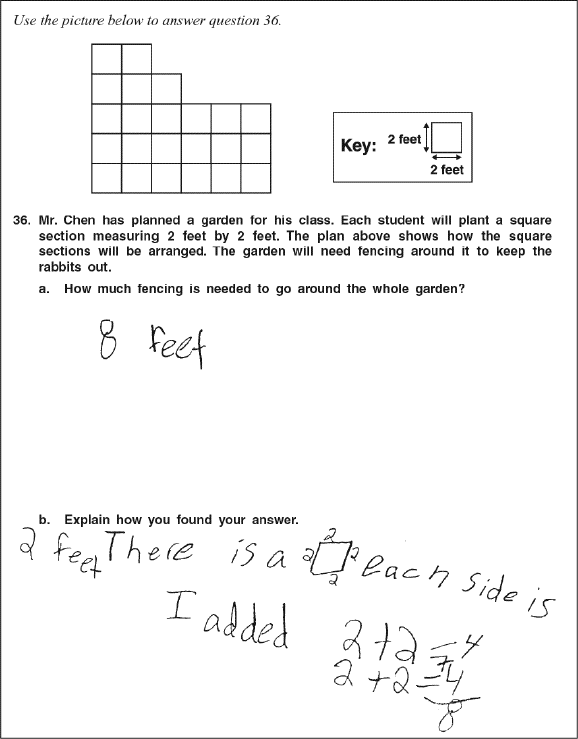
For more information visit: